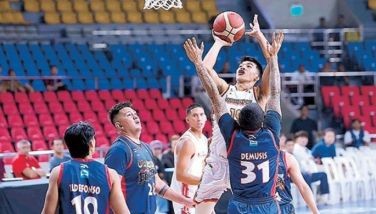Living on the island

The title makes for romantic suggestions, I’m sure. Who wouldn’t want to live on an island in the tropics? The sun kissing your skin, wind blowing in your face as you leisurely enjoy the effects of a cocktail or a stiff drink, surrounded by powdery white sand. All the right ingredients to forget the stress in your life.
Now, let’s do that all over but let’s make it even more colorful, real and dramatic. Once again, you’re living on an island but this time you are not surrounded by white sand, but soot-covered hard concrete. Instead of a beach chair or hammock to cushion you, your very own skin and flesh and a tattered piece of cardboard box comes between you and the heat and grime on the concrete island.
Because you’re somewhere between Makati and Manila, you’ve decided to get away from the scorching sun and hide under the canopy they call an expressway. Instead of cocktails and stiff drinks to give you a luxurious buzz, it’s malnutrition, dehydration and exhaustion that presses your entire body on the concrete island in between thousands and thousands of cars and trucks, providing you with a constant breeze of carbon monoxide. This is intoxication of a different kind and on a different level.
Everyone simply drives past, choosing to not see because if the Republic of the Philippines and the two local governments of Makati and Manila can’t or won’t help you, how can simple citizens, who are trying not to suffer the same fate, do anything?
Last Saturday, I took a Grab car to Ongpin St. in Chinatown and Waze directed the driver to pass the South Superhighway now called Osmeña Highway. It’s a route I rarely take and after seeing the poverty and inhumane conditions of adults and toddlers (or maybe they were severely stunted malnourished kids), I simply could not “move on” or forget it.
Whether they are genuine homeless people or “mga taong riles,” folks ejected from the PNR railway tracks or mentally ill people dumped by other LGUs, I don’t know. But I am certain that at some point in their lives they were considered human beings. I am hopeful that some can still be restored and saved or, at the very least, treated as human beings and not “refuse.”
I suspect that this failure of society and authorities – two mayors and a Cabinet secretary – is a direct result of the delegation of human and political responsibility through legislation such as the Local Government Code. The National Government simply washed their hands of responsibility and accountability by saying to LGUs: you got the money, you have the power, it’s YOUR responsibility.
This moral and criminal negligence to care for human beings is unforgiveable, considering the victims are in plain sight, suffering in silence and while they try to survive and beg for alms, agencies and departments tell us: “Don’t give because you are encouraging mendicancy and enriching the syndicates.”
Sorry, but that is utter bulls**t and the workings of people who are part of the problem and never the solution. How can people sprawled on the hot dusty polluted islands of Metro Manila be members of a “syndicate?” They can barely walk, they are passed out and starving and when starvation causes them to be delusional, we assume they are on drugs.
When Super Typhoon Yolanda hit Tacloban, we saw how hundreds of people were walking towards the next town like zombies. People assumed they were in shock, but responders said many of them had gone without food or drinking water for days. “Hilo sa gutom at pagod.” How much more for people whose lives are a metropolitan version of Typhoon Yolanda – no house, no food, no water and no sympathy!
The DSWD regularly calls attention to their 4Ps program of providing financial, health and social assistance to the poorest of the poor. Whoever came up with the guidelines did not study the accurate definition of poorest of the poor or just designed something that conveniently fit the DSWD’s bureaucratic requirement of recording and monitoring beneficiaries, all of whom have a roof over their head, a postal address and part of the voting population of local politicians.
What then do we call those people who don’t have a roof over their head, who don’t have a postal address and can’t be on the Voters List of politicians because they are literally dirt poor? What program does the DSWD have to restore, capacitate and integrate the “dirt poor” but human, living on the islands?
What is the Human Rights Commission doing about this particular problem? What is Congress doing in terms of passing a law that recognizes the human rights of the “dirt poor” and mandating their reintegration as productive citizens? While both institutions are busy kicking up dirt about human rights violations against leftists and drug users, I have not heard or seen any consistent effort or commitment to help the helpless and forsaken.
Considering the millions and millions of pesos that President Bongbong Marcos spends for his promotion and marketing trips for reputation management and investment promotion, PBBM should make it a point to take unscheduled, low-key drives along Quirino/Osmena highway, Kalayaan Avenue, Aurora Blvd. Pasay and Roxas Blvd., among others. This may not be the responsibility of a President, but it is a burden that falls on every human being who calls himself a leader.
When people see that it matters to the leader, the followers will follow.
* * *
E-mail: [email protected]
- Latest
- Trending




























